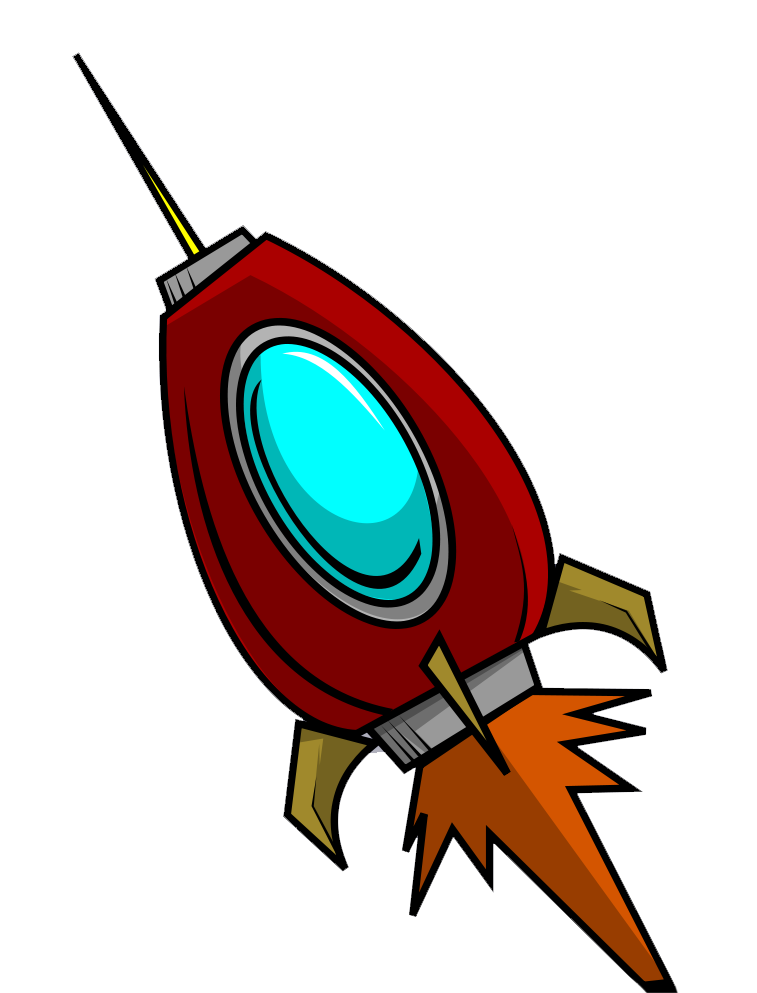Rocket Clipart
Rockets are spacecraft or missiles propelled upwards by the explosive force created from the rapid escape of gaseous exhaust. Humans have experimented with primitive rocket concepts for over two thousand years, but it took major advancements in science and engineering to transform rockets from crude novelties into the mighty launch vehicles that took astronauts to the Moon and probe the edges of our solar system.
Today rocket technologies continue advancing more rapidly than ever through space companies like SpaceX, NASA, and Blue Origin. Private rocket innovations make science fiction concepts like space tourism, extraterrestrial colonization and faster travel appear increasingly within reach over this century.
History of Rockets
The distinctive tapered rocket shape traces back to early firework-propelled arrows and celebratory flares used by the Chinese during the Han dynasty around 200 BC. Their formula for gunpowder rocket propulsion slowly spread westerly in the following centuries. Historically, rockets appeared more as weapons than science experiments – used incendiary for warfare or propelling inaccurate early European missiles.
By the 1900s, Konstantin Tsiolkovsky’s astronautics research pioneered serious formulation of rocket science theory. Robert Goddard built on this to successfully launch the first liquid-propelled rocket in 1926. The German V-2 rocket was the first long-range ballistic missile and its team of engineers later supplied rocket knowledge that jumpstarted the United States and Soviet space programs post-World War II.
How Rockets Work
Rockets function based on Newton’s third law stating that “every action has an equal and opposite reaction”. Fuel burns in the rocket engine to produce extremely hot, high-pressure gas that escapes violently out the exhaust end. This propels the rocket upwards with an equal force.
Steering rocket direction relies on subsidiary thrusters around the vehicle. Advanced onboard guidance computers ensure stabilization along the intended trajectory. Heat shields and protective fairings minimize damage from atmosphere friction and heat.
Rocket Parts
Main rocket parts include:
- Payload: People, satellites or spaceships carried to destination.
- Propellant: Fuel and oxidizers combining for combustion.
- Tanks: Containers holding propellant ingredients.
- Engines: Combustion devices that produce propelling gas.
- Pumps: Ensure steady propellant flow into combustion chambers.
- Guidance systems: Onboard computers, electronics andsoftware directing navigation.
- Frame structures: External casings containing internal components securely.
Rocket Propulsion
Rockets generate forward thrust using different types of engines and propellant combinations:
- Solid propellants: Simple, stable prepacked fuel binding agents. Ammonium perchlorate is common.
- Liquid propellants: Separate liquid components ignite upon mixing. Liquid hydrogen + liquid oxygen works well.
- Hybrid propellants: Mixture of solid and liquid propellants. Easier to throttle power output.
- Electric propulsion: Accelerates charged ions via electric fields for very high speeds!
- Nuclear propulsion: Proposed engines using nuclear reactions heat hydrogen propellant. Untested.
Types of Rockets
Modern rocket categories include:
Orbital launch vehicles send payloads into Earth orbit or escape trajectory using multi-stage rockets.
Cruise missiles guide themselves towards surface targets hundreds of miles away.
Intercontinental ballistic missiles (ICBMs) achieve sub-orbital arcing flight to distant targets.
Hobby rockets focus more on recreational launching rather than reaching orbit. Use commercial solid propellants.
Rocket planes combine traditional horizontal airfoil lifting surfaces with rocket boosting.
Space probes contain miniature long-range rockets to collect data across solar system.
Famous Rockets
Humanity’s vision to explore space depends on continued rocket innovations like:
- Saturn V (1967-1973) took astronauts to the Moon during Apollo program including first Moon walk. Massive rocket powered by liquid oxygen and kerosene.
- Falcon Heavy (2018-) SpaceX advanced partly reusable heavy lift launch vehicle relying on liquid oxygen and rocket grade kerosene.
- V-2 rocket (1944-1945) first long-range guided ballistic missile. Forerunner to spacefaring rockets despite original intention as Nazi “vengeance” weapon.
Rocket Science
Advancing rocket capabilities involves high-level expertise across STEM disciplines:
- Aerospace engineering: Designing structures surviving launch stresses, atmosphere transit, zero-gravity.
- Avionics: Electronics like guidance, telemetry, instrumentation (inside rockets).
- Combustion physics: Analyzing engine fuel mixes, nozzle shapes, injectors, cooling.
- Software programming: Onboard computers running automated navigation algorithms.
- Mission planning: Charting precise escapable orbits and flight plans.
Space Race
Following World War II, global militaries raced developing missile prototypes and orbital launch capabilities:
- Soviet Union – pioneered satellite and animal launch capabilities using imported German V-2 technology. Launched first human into orbit during Cold War tensions.
- United States – progressed from German imports into enormous homegrown rockets like Saturn V under newly formed NASA. Achieved crewed Moon landing in 1969.
- China – successful 2003 manned space mission highlighted their rapid technological ascendance and increased space activity.
Private companies like SpaceX, Blue Origin and Virgin Galactic now energize a commercial space race.
Competition driving innovation makes rockets bigger, safer and cheaper benefiting space exploration.
Rocket Clipart
Stylized rocket graphics help energize space-themed designs as iconic recognizable symbols of astronomy and futurism:
- Simple pointed projectiles emitting blasting plumes.
- Glowing engines emphasize sleek metallic hulls.
- Stars, galaxies in backdrop contextualize space mission and wonder.
- Retro mid-century modern aesthetic ties to Space Age nostalgia.
Rocket clipart continues inspiring t-shirts, posters, web graphics and more as near-universal visual shorthand for rocket science and epic space age adventures.
In this page clipartix present 60 rocket clipart images free for designing activities. Lets download Rocket Clipart that you want to use for works or personal uses.































































